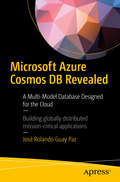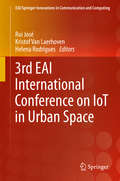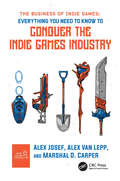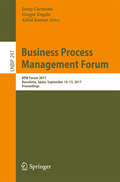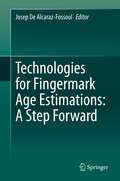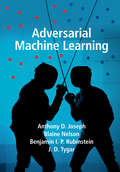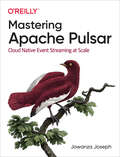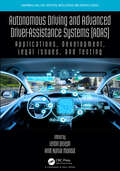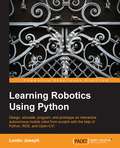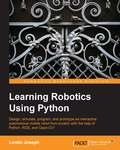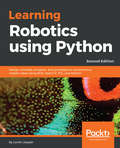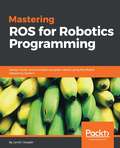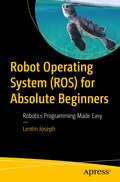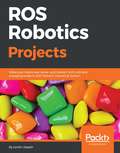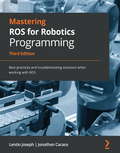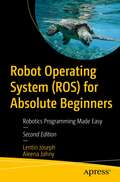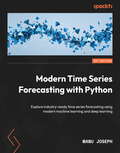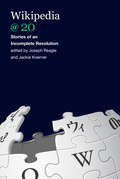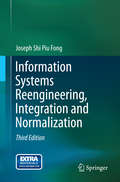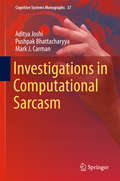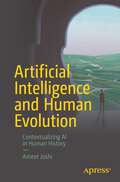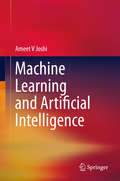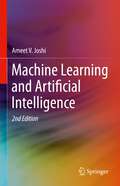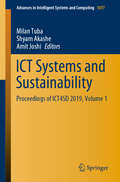- Table View
- List View
Microsoft Azure Cosmos DB Revealed: A Multi-Model Database Designed for the Cloud
by José Rolando Guay PazLearn the main features of Azure Cosmos DB and how to use Microsoft’s multi-model database service as a data store for mission-critical applications. The clear examples help in writing your own applications to take advantage of Cosmos DB’s multi-model, globally distributed, elastic database. Simple step-by-step instructions show how to resolve common and uncommon scenarios involving Azure Cosmos DB, and scenarios such as delivering extremely low response times (in the order of milliseconds), and scaling rapidly and globally.Microsoft Azure Cosmos DB Revealed demonstrates a multitude of possible implementations to get you started. This book guides you toward best practices to get the most out of Microsoft’s Cosmos DB service. Later chapters in the book cover advanced implementation features, helping you master important elements such as securing the database, querying, and using various APIs. What You'll LearnSet up a development environment to work with Azure Cosmos DBConfigure Azure Cosmos DB in a production environment with multi-region distributionQuery using all APIs, including SQL, JavaScript, MongoDB, and GraphWork with the Azure Cosmos DB.NET SDK in an application you builtAccess Cosmos DB from web applications created in .NETWho This Book Is ForDevelopers who build applications to be hosted in Microsoft Azure, whether they use PaaS or IaaS. No previous knowledge of Azure Cosmos DB is assumed, but readers must be familiar with developing applications in Microsoft Visual Studio.
3rd EAI International Conference on IoT in Urban Space (EAI/Springer Innovations in Communication and Computing)
by Rui José Kristof Van Laerhoven Helena RodriguesThis proceedings presents the papers from Urb-IoT 2018 - 3rd EAI International Conference on IoT in Urban Space, which took place in Guimarães, Portugal on 21-22 November 2018. The conference aims to explore the emerging dynamics within the scope of the Internet of Things (IoT) and the new science of cities.The papers discuss fusion of heterogeneous urban sources, understanding urban data using machine learning and mining techniques, urban analytics, urban IoT infrastructures, crowd sourcing techniques, incentification and gamification, urban mobility and intelligent transportation systems, real time urban information systems, and more. The proceedings discuss innovative technologies that navigate industry and connectivity sectors in transportation, utility, public safety, healthcare, and education. The authors also discuss the increasing deployments of IoT technologies and the rise of the so-called 'Sensored Cities'‚ which are opening up new avenues of research opportunities towards that future.
The Business of Indie Games: Everything You Need to Know to Conquer the Indie Games Industry
by Alex Josef Alex Van Lepp Marshal D. Carper"The Business of Indie Games provides exceptional insight into how the video games industry works. It shares valuable information on how to successfully self-publish and secure publisher support. Whether you’re making your first game or tenth, this book is a must read." – Paul Baldwin, Curve Digital "The video game industry is a tough business and anyone looking to succeed in indie development should give The Business of Indie Games a read." – Graham Smith, Co-Founder of DrinkBox Studios "This book is a fast track to success for anyone managing a game launch and looking to raise funding for their projects. It shares knowledge that you only learn after years of triumphs and failures within this industry." – Scott Drader, Co-Founder of Metalhead Software "There’s nothing like The Business of Indie Games taught in school. You learn how to make a game, but not how to conduct business, market, and launch a game. This book dives into topics that every indie developer should know." – Yukon Wainczak, Founder of Snoozy Kazoo "I’ve seen no better guide for understanding how the video game industry really works. An important read for anyone whose work touches games, including those of us looking to engage the community." – Carla Warner, Director of STREAM for No Kid Hungry The Business of Indie Games explores what many universities forget to cover: how to sell and market your own indie game to potential publishers and developers. While many classes help students on their way to designing and programming their own games, there are few classes that equip students with the skills to sell their own product. In essence, this means future indie game developers are not equipped to talk to investors, negotiate with publishers, and engage with major platforms like Steam and Nintendo. Authors Alex Josef, Alex Van Lepp, and Marshal D. Carper are looking to rectify this problem by helping indie game developers and companies level up their business acumen. With detailed chapters and sections that deal with different engines, negotiation tactics, and marketing, The Business of Indie Games is the perfect omnibus for up-and-coming indie game developers. The future of gaming curriculums is not just in teaching students how to create games but also in preparing them for the business of games.
Business Process Management Forum: BPM Forum 2017, Barcelona, Spain, September 10-15, 2017, Proceedings (Lecture Notes in Business Information Processing #297)
by Josep Carmona, Gregor Engels and Akhil KumarThis book constitutes the proceedings of the BPM Forum from the International Conference on Business Process Management, BPM 2017, held in Barcelona, Spain, September 2017. The BPM Forum hosts innovative research which has a high potential of stimulating discussions. The papers selected for the forum are expected to showcase fresh ideas from exciting and emerging topics in BPM, even if they are not yet as mature as the regular papers at the conference. The volume contains 11 full papers carefully reviewed and selected from 97 submissions. Each paper was reviewed by a team comprising of a senior PC and four regular PC members who engage in a discussion phase after the initial reviews were prepared. The authors eventually receive four review reports, and a meta-review that summarizes the reviews and the discussion. The selected papers cover topics related to process models and metrics, mining and compliance, and to other innovative ideas such as gamification, smart devices and digital innovation as far as they pertain to BPM.
Technologies for Fingermark Age Estimations: A Step Forward
by Josep De Alcaraz-FossoulThis book discusses new applications of technologies that have been or could be successfully employed to estimate the age of fingermarks. Determining the specific time a fingermark is deposited could become a powerful new development in forensic science and a useful application to law enforcement. This book aims to shed some light on this important and still controversial area of scientific research. The expert chapters review recent discoveries and current developments with a practical bent, focusing on prospective uses in real-world crime scenes. They take a multidisciplinary approach, featuring contributors with diverse specialties including Chemistry, Imaging Technologies, Forensic Science, Biology and Microbiology. The balanced presentation incorporates critiques on fingermark aging studies, explores the reliability of fingermarks as evidence, and discusses how the estimation of “age” can improve robustness of crime evidence. Each chapter describes a unique aspect of fingermark aging observed from a different analytical perspective: 2D imaging; 3D imaging; chemical analysis; chemical imaging; microbiome analysis; electrochemical analysis; and DNA analysis, as well as the role and application of statistics. Illustrations and graphs aid the reader in understanding the concepts being explained. Not just a compilation of techniques and methods, this book’s emphasis on practical applications and its easy-to-read style will appeal to a broad audience of scientists and criminal justice professionals alike. It will be of great interest to law enforcement, academia, and the criminal justice community; including forensic scientists, investigators, lawyers, students, and researchers. It aims to help facilitate debates in the broader community about the feasibility, convenience, and relevance of estimating the age of evidence.
Adversarial Machine Learning
by Anthony D. Joseph Blaine Nelson Benjamin I. Rubinstein J. D. TygarWritten by leading researchers, this complete introduction brings together all the theory and tools needed for building robust machine learning in adversarial environments. Discover how machine learning systems can adapt when an adversary actively poisons data to manipulate statistical inference, learn the latest practical techniques for investigating system security and performing robust data analysis, and gain insight into new approaches for designing effective countermeasures against the latest wave of cyber-attacks. Privacy-preserving mechanisms and the near-optimal evasion of classifiers are discussed in detail, and in-depth case studies on email spam and network security highlight successful attacks on traditional machine learning algorithms. Providing a thorough overview of the current state of the art in the field, and possible future directions, this groundbreaking work is essential reading for researchers, practitioners and students in computer security and machine learning, and those wanting to learn about the next stage of the cybersecurity arms race.
Mastering Apache Pulsar: Cloud Native Event Streaming At Scale
by Jowanza JosephEvery enterprise application creates data, including log messages, metrics, user activity, and outgoing messages. Learning how to move these items is almost as important as the data itself. If you're an application architect, developer, or production engineer new to Apache Pulsar, this practical guide shows you how to use this open source event streaming platform to handle real-time data feeds.Jowanza Joseph, staff software engineer at Finicity, explains how to deploy production Pulsar clusters, write reliable event streaming applications, and build scalable real-time data pipelines with this platform. Through detailed examples, you'll learn Pulsar's design principles, reliability guarantees, key APIs, and architecture details, including the replication protocol, the load manager, and the storage layer.This book helps you:Understand how event streaming fits in the big data ecosystemExplore Pulsar producers, consumers, and readers for writing and reading eventsBuild scalable data pipelines by connecting Pulsar with external systemsSimplify event-streaming application building with Pulsar FunctionsManage Pulsar to perform monitoring, tuning, and maintenance tasksUse Pulsar's operational measurements to secure a production clusterProcess event streams using Flink and query event streams using Presto
Autonomous Driving and Advanced Driver-Assistance Systems: Applications, Development, Legal Issues, and Testing (Chapman & Hall/CRC Artificial Intelligence and Robotics Series)
by Lentin JosephAutonomous Driving and Advanced Driver-Assistance Systems (ADAS): Applications, Development, Legal Issues, and Testing outlines the latest research related to autonomous cars and advanced driver-assistance systems, including the development, testing, and verification for real-time situations of sensor fusion, sensor placement, control algorithms, and computer vision. Features: Co-edited by an experienced roboticist and author and an experienced academic Addresses the legal aspect of autonomous driving and ADAS Presents the application of ADAS in autonomous vehicle parking systems With an infinite number of real-time possibilities that need to be addressed, the methods and the examples included in this book are a valuable source of information for academic and industrial researchers, automotive companies, and suppliers.
Learning Robotics Using Python
by Lentin JosephIf you are an engineer, a researcher, or a hobbyist, and you are interested in robotics and want to build your own robot, this book is for you. Readers are assumed to be new to robotics but should have experience with Python.
Learning Robotics Using Python
by Lentin Joseph<P><P>Design, simulate, program, and prototype an interactive autonomous mobile robot from scratch with the help of Python, ROS, and Open-CV! <P><P>About This Book <P><P>Design, simulate, build and program an interactive autonomous mobile robot <P><P>Program Robot Operating System using Python <P><P>Get a grip on the hands-on guide to robotics for learning various robotics concepts and build an advanced robot from scratch <P><P>Who This Book Is For <P><P>If you are an engineer, a researcher, or a hobbyist, and you are interested in robotics and want to build your own robot, this book is for you. Readers are assumed to be new to robotics but should have experience with Python. <P><P>What You Will Learn <P><P>Understand the core concepts and terminologies of robotics <P><P>Create 2D and 3D drawings of robots using freeware such as LibreCAD and Blender <P><P>Simulate your robot using ROS and Gazebo <P><P>Build robot hardware from the requirements <P><P>Explore a diverse range of actuators and its interfacing <P><P>Interface various robotic sensors to robots <P><P>Set up and program OpenCV, OpenNI, and PCL to process 2D/3D visual data <P><P>Learn speech processing and synthesis using Python <P><P>Apply artificial intelligence to robots using Python <P><P>Build a robot control GUI using Qt and Python <P><P>Calibration and testing of robot <P><P>In Detail <P><P>Learning about robotics will become an increasingly essential skill as it becomes a ubiquitous part of life. Even though robotics is a complex subject, several other tools along with Python can help you design a project to create an easy-to-use interface. <P><P>Learning Robotics Using Python is an essential guide for creating an autonomous mobile robot using popular robotic software frameworks such as ROS using Python. It also discusses various robot software frameworks and how to go about coding the robot using Python and its framework. It concludes with creating a GUI-based application to control the robot using buttons and slides. <P><P>By the end of this tutorial, you'll have a clear idea of how to integrate and assemble all things into a robot and how to bundle the software package.
Learning Robotics using Python: Design, simulate, program, and prototype an autonomous mobile robot using ROS, OpenCV, PCL, and Python, 2nd Edition
by Lentin JosephDesign, simulate, and program interactive robots Key Features Design, simulate, build, and program an interactive autonomous mobile robot Leverage the power of ROS, Gazebo, and Python to enhance your robotic skills A hands-on guide to creating an autonomous mobile robot with the help of ROS and PythonBook DescriptionRobot Operating System (ROS) is one of the most popular robotics software frameworks in research and industry. It has various features for implement different capabilities in a robot without implementing them from scratch.This book starts by showing you the fundamentals of ROS so you understand the basics of differential robots. Then, you'll learn about robot modeling and how to design and simulate it using ROS. Moving on, we'll design robot hardware and interfacing actuators. Then, you'll learn to configure and program depth sensors and LIDARs using ROS. Finally, you'll create a GUI for your robot using the Qt framework. By the end of this tutorial, you'll have a clear idea of how to integrate and assemble everything into a robot and how to bundle the software package.What you will learn Design a differential robot from scratch Model a differential robot using ROS and URDF Simulate a differential robot using ROS and Gazebo Design robot hardware electronics Interface robot actuators with embedded boards Explore the interfacing of different 3D depth cameras in ROS Implement autonomous navigation in ChefBot Create a GUI for robot controlWho this book is forThis book is for those who are conducting research in mobile robotics and autonomous navigation. As well as the robotics research domain, this book is also for the robot hobbyist community. You’re expected to have a basic understanding of Linux commands and Python.
Mastering ROS for Robotics Programming
by Lentin Joseph<P><P>Design, build and simulate complex robots using Robot Operating System and master its out-of-the-box functionalities <P><P>Key Features <P><P>Develop complex robotic applications using ROS for interfacing robot manipulators and mobile robots with the help of high end robotic sensors <P><P>Gain insights into autonomous navigation in mobile robot and motion planning in robot manipulators <P><P>Discover the best practices and troubleshooting solutions everyone needs when working on ROS <P><P>Book Description <P><P>The area of robotics is gaining huge momentum among corporate people, researchers, hobbyists, and students. The major challenge in robotics is its controlling software. The Robot Operating System (ROS) is a modular software platform to develop generic robotic applications. <P><P>This book discusses the advanced concepts in robotics and how to program using ROS. It starts with deep overview of the ROS framework, which will give you a clear idea of how ROS really works. During the course of the book, you will learn how to build models of complex robots, and simulate and interface the robot using the ROS MoveIt motion planning library and ROS navigation stacks. <P><P>After discussing robot manipulation and navigation in robots, you will get to grips with the interfacing I/O boards, sensors, and actuators of ROS. One of the essential ingredients of robots are vision sensors, and an entire chapter is dedicated to the vision sensor, its interfacing in ROS, and its programming. <P><P>You will discuss the hardware interfacing and simulation of complex robot to ROS and ROS Industrial (Package used for interfacing industrial robots). <P><P>Finally, you will get to know the best practices to follow when programming using ROS. <P><P>What you will learn <P><P>Create a robot model of a Seven-DOF robotic arm and a differential wheeled mobile robot <P><P>Work with motion planning of a Seven-DOF arm using MoveIt! <P><P>Implement autonomous navigation in differential drive robots using SLAM and AMCL packages in ROS <P><P>Dig deep into the ROS Pluginlib, ROS nodelets, and Gazebo plugins <P><P>Interface I/O boards such as Arduino, Robot sensors, and High end actuators with ROS <P><P>Simulation and motion planning of ABB and Universal arm using ROS Industrial <P><P>Explore the ROS framework using its latest version
Robot Operating System for Absolute Beginners: Robotics Programming Made Easy
by Lentin JosephLearn how to get started with robotics programming using Robot Operation System (ROS). Targeted for absolute beginners in ROS, Linux, and Python, this short guide shows you how to build your own robotics projects.ROS is an open-source and flexible framework for writing robotics software. With a hands-on approach and sample projects, Robot Operating System for Absolute Beginners will enable you to begin your first robot project. You will learn the basic concepts of working with ROS and begin coding with ROS APIs in both C++ and Python.What You’ll LearnInstall ROSReview fundamental ROS conceptsWork with frequently used commands in ROSBuild a mobile robot from scratch using ROSWho This Book Is ForAbsolute beginners with little to no programming experience looking to learn robotics programming.
ROS Robotics Projects
by Lentin JosephBuild a variety of awesome robots that can see, sense, move, and do a lot more using the powerful Robot Operating System About This Book • Create and program cool robotic projects using powerful ROS libraries • Work through concrete examples that will help you build your own robotic systems of varying complexity levels • This book provides relevant and fun-filled examples so you can make your own robots that can run and work Who This Book Is For This book is for robotic enthusiasts and researchers who would like to build robot applications using ROS. If you are looking to explore advanced ROS features in your projects, then this book is for you. Basic knowledge of ROS, GNU/Linux, and programming concepts is assumed. What You Will Learn • Create your own self-driving car using ROS • Build an intelligent robotic application using deep learning and ROS • Master 3D object recognition • Control a robot using virtual reality and ROS • Build your own AI chatter-bot using ROS • Get to know all about the autonomous navigation of robots using ROS • Understand face detection and tracking using ROS • Get to grips with teleoperating robots using hand gestures • Build ROS-based applications using Matlab and Android • Build interactive applications using TurtleBot In Detail Robot Operating System is one of the most widely used software frameworks for robotic research and for companies to model, simulate, and prototype robots. Applying your knowledge of ROS to actual robotics is much more difficult than people realize, but this title will give you what you need to create your own robotics in no time! This book is packed with over 14 ROS robotics projects that can be prototyped without requiring a lot of hardware. The book starts with an introduction of ROS and its installation procedure. After discussing the basics, you'll be taken through great projects, such as building a self-driving car, an autonomous mobile robot, and image recognition using deep learning and ROS. You can find ROS robotics applications for beginner, intermediate, and expert levels inside! This book will be the perfect companion for a robotics enthusiast who really wants to do something big in the field. Style and approach This book is packed with fun-filled, end-to-end projects on mobile, armed, and flying robots, and describes the ROS implementation and execution of these models.
Mastering ROS for Robotics Programming: Best practices and troubleshooting solutions when working with ROS, 3rd Edition
by Lentin Joseph Jonathan CacaceDesign, build, and simulate complex robots using the Robot Operating SystemKey FeaturesBecome proficient in ROS programming using C++ with this comprehensive guideBuild complex robot applications using the ROS Noetic Ninjemys release to interface robot manipulators with mobile robotsLearn to interact with aerial robots using ROSBook DescriptionThe Robot Operating System (ROS) is a software framework used for programming complex robots. ROS enables you to develop software for building complex robots without writing code from scratch, saving valuable development time. Mastering ROS for Robotics Programming provides complete coverage of the advanced concepts using easy-to-understand, practical examples and step-by-step explanations of essential concepts that you can apply to your ROS robotics projects. The book begins by helping you get to grips with the basic concepts necessary for programming robots with ROS. You'll then discover how to develop a robot simulation, as well as an actual robot, and understand how to apply high-level capabilities such as navigation and manipulation from scratch. As you advance, you'll learn how to create ROS controllers and plugins and explore ROS's industrial applications and how it interacts with aerial robots. Finally, you'll discover best practices and methods for working with ROS efficiently. By the end of this ROS book, you'll have learned how to create various applications in ROS and build your first ROS robot.What you will learnCreate a robot model with a 7-DOF robotic arm and a differential wheeled mobile robotWork with Gazebo, CoppeliaSim, and Webots robotic simulatorsImplement autonomous navigation in differential drive robots using SLAM and AMCL packagesInteract with and simulate aerial robots using ROSExplore ROS pluginlib, ROS nodelets, and Gazebo pluginsInterface I/O boards such as Arduino, robot sensors, and high-end actuatorsSimulate and perform motion planning for an ABB robot and a universal arm using ROS-IndustrialWork with the motion planning features of a 7-DOF arm using MoveIt Who this book is forIf you are a robotics graduate, robotics researcher, or robotics software professional looking to work with ROS, this book is for you. Programmers who want to explore the advanced features of ROS will also find this book useful. Basic knowledge of ROS, GNU/Linux, and C++ programming concepts is necessary to get started with this book.
ROS Robotics Projects: Build and control robots powered by the Robot Operating System, machine learning, and virtual reality, 2nd Edition
by Lentin Joseph Ramkumar GandhinathanBuild exciting robotics projects such as mobile manipulators, self-driving cars, and industrial robots powered by ROS, machine learning, and virtual reality Key Features Create and program cool robotic projects using powerful ROS libraries Build industrial robots like mobile manipulators to handle complex tasks Learn how reinforcement learning and deep learning are used with ROS Book Description Nowadays, heavy industrial robots placed in workcells are being replaced by new age robots called cobots, which don't need workcells. They are used in manufacturing, retail, banks, energy, and healthcare, among other domains. One of the major reasons for this rapid growth in the robotics market is the introduction of an open source robotics framework called the Robot Operating System (ROS). This book covers projects in the latest ROS distribution, ROS Melodic Morenia with Ubuntu Bionic (18.04). Starting with the fundamentals, this updated edition of ROS Robotics Projects introduces you to ROS-2 and helps you understand how it is different from ROS-1. You'll be able to model and build an industrial mobile manipulator in ROS and simulate it in Gazebo 9. You'll then gain insights into handling complex robot applications using state machines and working with multiple robots at a time. This ROS book also introduces you to new and popular hardware such as Nvidia's Jetson Nano, Asus Tinker Board, and Beaglebone Black, and allows you to explore interfacing with ROS. You'll learn as you build interesting ROS projects such as self-driving cars, making use of deep learning, reinforcement learning, and other key AI concepts. By the end of the book, you'll have gained the confidence to build interesting and intricate projects with ROS. What you will learn Grasp the basics of ROS and understand ROS applications Uncover how ROS-2 is different from ROS-1 Handle complex robot tasks using state machines Communicate with multiple robots and collaborate to build apps with them Explore ROS capabilities with the latest embedded boards such as Tinker Board S and Jetson Nano Discover how machine learning and deep learning techniques are used with ROS Build a self-driving car powered by ROS Teleoperate your robot using Leap Motion and a VR headset Who this book is for If you're a student, hobbyist, professional, or anyone with a passion for learning robotics and interested in learning about algorithms, motion control, and perception capabilities from scratch, this book is for you. This book is also ideal for anyone who wants to build a new product and for researchers to make the most of what's already available to create something new and innovative in the field of robotics.
Robot Operating System (ROS) for Absolute Beginners: Robotics Programming Made Easy
by Lentin Joseph Aleena JohnyStart programming your own robots using Robot Operation System (ROS). Targeted for absolute beginners in ROS, Linux, and Python, this guide lets you build your own robotics projects. You'll learn the basic foundation of Ubuntu Linux. Begin with the fundamentals. Installation and useful commands will give you the basic tools you need while programming a robot. Then add useful software applications that can be used while making robots. Programming robots can be done using any of the programming languages. Most popular programming languages are Python and C++. You will incorporate the fundamentals of C++ by learning object oriented programing concepts from example and building C++ projects.Finally, tackle an ROS hands-on project to apply all the concepts of ROS you've learned. The aim of the project is to perform a dead-reckoning using a cheap mobile robot. You can command your robot's position on Rviz and your robot will move to that position! Not only will you learn to program, you'll gain hands-on experience working with hardware to create a real robot.What You’ll LearnInstall Ubuntu 20Install ROS NoeticUse ROS Programming with roscpp and rospy Build a mobile robot from scratch using ROSWho This Book Is ForRobotics enthusiast with little or no prior programming experience.
Modern Time Series Forecasting with Python: Explore industry-ready time series forecasting using modern machine learning and deep learning
by Manu JosephBuild real-world time series forecasting systems which scale to millions of time series by applying modern machine learning and deep learning conceptsKey FeaturesExplore industry-tested machine learning techniques used to forecast millions of time seriesGet started with the revolutionary paradigm of global forecasting modelsGet to grips with new concepts by applying them to real-world datasets of energy forecastingBook DescriptionWe live in a serendipitous era where the explosion in the quantum of data collected and a renewed interest in data-driven techniques such as machine learning (ML), has changed the landscape of analytics, and with it, time series forecasting. This book, filled with industry-tested tips and tricks, takes you beyond commonly used classical statistical methods such as ARIMA and introduces to you the latest techniques from the world of ML. This is a comprehensive guide to analyzing, visualizing, and creating state-of-the-art forecasting systems, complete with common topics such as ML and deep learning (DL) as well as rarely touched-upon topics such as global forecasting models, cross-validation strategies, and forecast metrics. You'll begin by exploring the basics of data handling, data visualization, and classical statistical methods before moving on to ML and DL models for time series forecasting. This book takes you on a hands-on journey in which you'll develop state-of-the-art ML (linear regression to gradient-boosted trees) and DL (feed-forward neural networks, LSTMs, and transformers) models on a real-world dataset along with exploring practical topics such as interpretability. By the end of this book, you'll be able to build world-class time series forecasting systems and tackle problems in the real world.What you will learnFind out how to manipulate and visualize time series data like a proSet strong baselines with popular models such as ARIMADiscover how time series forecasting can be cast as regressionEngineer features for machine learning models for forecastingExplore the exciting world of ensembling and stacking modelsGet to grips with the global forecasting paradigmUnderstand and apply state-of-the-art DL models such as N-BEATS and AutoformerExplore multi-step forecasting and cross-validation strategiesWho this book is forThe book is for data scientists, data analysts, machine learning engineers, and Python developers who want to build industry-ready time series models. Since the book explains most concepts from the ground up, basic proficiency in Python is all you need. Prior understanding of machine learning or forecasting will help speed up your learning. For experienced machine learning and forecasting practitioners, this book has a lot to offer in terms of advanced techniques and traversing the latest research frontiers in time series forecasting.
Wikipedia @ 20: Stories of an Incomplete Revolution
by Joseph Reagle and Jackie KoernerWikipedia's first twenty years: how what began as an experiment in collaboration became the world's most popular reference work.We have been looking things up in Wikipedia for twenty years. What began almost by accident--a wiki attached to an nascent online encyclopedia--has become the world's most popular reference work. Regarded at first as the scholarly equivalent of a Big Mac, Wikipedia is now known for its reliable sourcing and as a bastion of (mostly) reasoned interaction. How has Wikipedia, built on a model of radical collaboration, remained true to its original mission of "free access to the sum of all human knowledge" when other tech phenomena have devolved into advertising platforms? In this book, scholars, activists, and volunteers reflect on Wikipedia's first twenty years, revealing connections across disciplines and borders, languages and data, the professional and personal.
Information Systems Reengineering, Integration and Normalization
by Joseph Shi Piu FongTaking a very practical approach, the author describes in detail database conversion techniques, reverse engineering, forward engineering and re-engineering methodologies for information systems, offering a systematic software engineering approach for reusing existing database systems built with "old" technology. He demonstrates how the existing systems can be transformed into the new technologies with the preservation of semantic constraints and without loss of information. In this third edition, with a new chapter on Data Normalization the author shows once the databases have been converted, how to integrate them for consolidating information, and how to normalize them so that they are efficient and user friendly. Many examples, illustrations and case studies together with questions and answers ensure that the methodology is easy to follow. Ideal as a textbook for students studying information systems theories, Information Systems Reengineering Integration and Normalization will also be a valuable management reference book for Information Technology Practitioners. Additional material is available on www. extramaterials/978-3-319-12294-6
Investigations in Computational Sarcasm (Cognitive Systems Monographs #37)
by Aditya Joshi Pushpak Bhattacharyya Mark J. CarmanThis book describes the authors’ investigations of computational sarcasm based on the notion of incongruity. In addition, it provides a holistic view of past work in computational sarcasm and the challenges and opportunities that lie ahead. Sarcastic text is a peculiar form of sentiment expression and computational sarcasm refers to computational techniques that process sarcastic text. To first understand the phenomenon of sarcasm, three studies are conducted: (a) how is sarcasm annotation impacted when done by non-native annotators? (b) How is sarcasm annotation impacted when the task is to distinguish between sarcasm and irony? And (c) can targets of sarcasm be identified by humans and computers. Following these studies, the book proposes approaches for two research problems: sarcasm detection and sarcasm generation. To detect sarcasm, incongruity is captured in two ways: ‘intra-textual incongruity’ where the authors look at incongruity within the text to be classified (i.e., target text) and ‘context incongruity’ where the authors incorporate information outside the target text. These approaches use machine-learning techniques such as classifiers, topic models, sequence labelling, and word embeddings. These approaches operate at multiple levels: (a) sentiment incongruity (based on sentiment mixtures), (b) semantic incongruity (based on word embedding distance), (c) language model incongruity (based on unexpected language model), (d) author’s historical context (based on past text by the author), and (e) conversational context (based on cues from the conversation). In the second part of the book, the authors present the first known technique for sarcasm generation, which uses a template-based approach to generate a sarcastic response to user input. This book will prove to be a valuable resource for researchers working on sentiment analysis, especially as applied to automation in social media.
Artificial Intelligence and Human Evolution: Contextualizing AI in Human History
by Ameet JoshiThis book explores, from a high level, the parallels between the evolution of humans and the evolution of machines. The book reviews practical questions about the future of AI but also engages in philosophical discussions about what machine intelligence could mean for the human experience.The book focuses on what is intelligence and what separates intelligent species from non-so-intelligent ones. It concludes this section with the description of true nature of humanintelligence can be. We discuss how we looked at machines few hundred years back and how their definition and the expectations from them has changed over time. We will consider when and how machines became intelligent and then explore in depth he latest developments in artificial intelligence with explanation of deep learning technology and humanlike chat interface provided with products like ChatGPT. We will define both human intelligence and artificial intelligence and the distinction between the two.In the third and final section of the book, we will focus on near- and longer-term futures with widespread use of machine intelligence, making the whole ambient environment that we will live in intelligent How is this going to change human lives, and what parts of human life will be encroached with machines and their intelligence? We will explore how the job market will look with some jobs being taken by machines, and if this is overall a positive or negative change. What You Will LearnHow human intelligence is connected with artificial intelligence as well as the differencesHow AI is going to change our lives in the coming years, decades and centuriesAn explanation of deep learning technology and humanlike chat interface provided with products like ChatGPTWho This Book is ForReaders looking to contextualize the evolution of artificial intelligence in human history
Machine Learning and Artificial Intelligence
by Ameet V JoshiThis book provides comprehensive coverage of combined Artificial Intelligence (AI) and Machine Learning (ML) theory and applications. Rather than looking at the field from only a theoretical or only a practical perspective, this book unifies both perspectives to give holistic understanding. The first part introduces the concepts of AI and ML and their origin and current state. The second and third parts delve into conceptual and theoretic aspects of static and dynamic ML techniques. The forth part describes the practical applications where presented techniques can be applied. The fifth part introduces the user to some of the implementation strategies for solving real life ML problems. The book is appropriate for students in graduate and upper undergraduate courses in addition to researchers and professionals. It makes minimal use of mathematics to make the topics more intuitive and accessible.Presents a full reference to artificial intelligence and machine learning techniques - in theory and application;Provides a guide to AI and ML with minimal use of mathematics to make the topics more intuitive and accessible;Connects all ML and AI techniques to applications and introduces implementations.
Machine Learning and Artificial Intelligence
by Ameet V JoshiThe new edition of this popular professional book on artificial intelligence (ML) and machine learning (ML) has been revised for classroom or training use. The new edition provides comprehensive coverage of combined AI and ML theory and applications. Rather than looking at the field from only a theoretical or only a practical perspective, this book unifies both perspectives to give holistic understanding. The first part introduces the concepts of AI and ML and their origin and current state. The second and third parts delve into conceptual and theoretic aspects of static and dynamic ML techniques. The fourth part describes the practical applications where presented techniques can be applied. The fifth part introduces the user to some of the implementation strategies for solving real life ML problems. Each chapter is accompanied with a set of exercises that will help the reader / student to apply the learnings from the chapter to a real-life problem. Completion of these exercises will help the reader / student to solidify the concepts learned. The book is appropriate for students in graduate and upper undergraduate courses in addition to researchers and professionals. It makes minimal use of mathematics to make the topics more intuitive and accessible. The book covers a large gamut of topics in the area of AI and ML and a professor can tailor a course on AI / ML based on the book by selecting and re-organizing the sequence of chapters to suit the needs.
ICT Systems and Sustainability: Proceedings of ICT4SD 2019, Volume 1 (Advances in Intelligent Systems and Computing #1077)
by Amit Joshi Shyam Akashe Milan TubaThis book proposes new technologies and discusses future solutions for ICT design infrastructures, as reflected in high-quality papers presented at the 4th International Conference on ICT for Sustainable Development (ICT4SD 2019), held in Goa, India, on 5–6 July 2019. The conference provided a valuable forum for cutting-edge research discussions among pioneering researchers, scientists, industrial engineers, and students from all around the world. Bringing together experts from different countries, the book explores a range of central issues from an international perspective.
